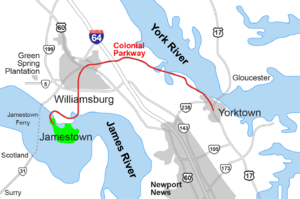Historic Triangle facts for kids


The Historic Triangle is a special area in Virginia with three important historical towns: Jamestown, Colonial Williamsburg, and Yorktown. These towns are located on the Virginia Peninsula, between the York River and the James River. They are connected by a beautiful road called the Colonial Parkway.
These places are super important because they tell the story of early America. A wise person once said, "Williamsburg is Jamestown continued, and Yorktown is Williamsburg vindicated." This means that Williamsburg carried on the ideas from Jamestown, and Yorktown proved those ideas were right.
Contents
Exploring the Colonial Parkway
The National Park Service built the Colonial Parkway to connect these three historic places. It's a scenic road that feels like a trip back in time. You won't see modern buildings from most of the parkway. Instead, you'll enjoy views of rivers, nature, and even wildlife like birds and other animals.
There are special spots along the parkway where you can pull over and enjoy the view of the James River or York River. The best part is, there are no tolls or fees to drive on the Colonial Parkway! It starts in Yorktown, goes through Colonial Williamsburg, and ends in Jamestown. Only regular cars are allowed on this road, not big commercial trucks.
Riding the Jamestown Ferry
Some visitors arrive at the Historic Triangle by crossing the James River on a ferry. These ferries travel from Surry County to Jamestown Island. You can drive your car onto one of the four Jamestown Ferries, like the Pocahontas or Williamsburg.
While crossing, you can leave your car and walk around. There's even an enclosed area with restrooms and great views. On a nice day, you might see Jamestown Island looking much like it did when the first English colonists arrived. Replicas of the three ships they sailed on—the Susan Constant, Godspeed, and Discovery—are docked near the ferry landing. This ferry service is free!
Discovering Jamestown's History
Jamestown is where the first permanent English settlement in the New World was established on May 13, 1607. It's a really important place for American history! Today, there are two main sites to explore here.
One is Jamestown Settlement, which is a living history museum. It has a reconstructed Native American village, a colonial fort, and those replica ships we mentioned. The other site is Historic Jamestowne, managed by the National Park Service. This includes the actual Jamestown Island and ongoing archaeological digs where experts are still uncovering new discoveries.
Exploring Colonial Williamsburg
In 1699, the capital of Virginia moved from Jamestown to a higher area called Middle Plantation. Students from the College of William and Mary, which started there in 1693, suggested the move. Middle Plantation was soon renamed Williamsburg to honor King William III. It was a very busy and important city until the American Revolution.
During the American Revolutionary War in 1780, the capital moved again to Richmond for safety. For nearly 150 years, Williamsburg became a quiet town. But in the early 1900s, a minister named Reverend Dr. W.A.R. Goodwin and a wealthy man named John D. Rockefeller Jr. had a dream. They wanted to restore the old colonial capital to how it looked in the 1700s.
Their hard work created Colonial Williamsburg, a huge living museum of early American life. It has 88 original buildings and many more that have been carefully restored or rebuilt. You can see people dressed in colonial clothes, acting out daily life from that time. It's one of the most popular tourist spots in the world! There's a Visitor Center with a short movie and parking, as cars aren't allowed in the main historic area. Shuttle buses take visitors around.
Visiting Yorktown
The third point of the Historic Triangle is Yorktown. This is where a very important event happened in 1781: General Cornwallis surrendered to George Washington in the last major land battle of the American Revolution. This surrender helped America win its independence!
Today, Yorktown has two large visitor centers, special drives around the battlefield, and a charming waterfront area. The historic downtown area still has many buildings from before the Revolutionary War.
Fun Things to Do Nearby
While the Historic Triangle focuses on the past, there are also many modern attractions nearby. You can find hotels, restaurants, shops, and other fun places to visit.
Other popular attractions in the area include:
- Busch Gardens, a fantastic theme park in James City County.
- Go-Karts Plus, another theme park near Williamsburg with fun go-karts.
- Water Country USA, a cool water park located in York County.
- The Williamsburg Winery, Virginia's largest winery, set on a big farm.
- Williamsburg Pottery Factory, a unique shopping destination with many different items.
See also
- Hampton Roads
- American Revolution Museum at Yorktown

